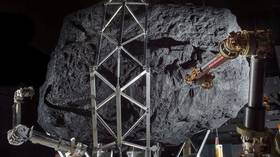Alien probes spying on Earth? Scientist warns of possible ‘lurkers’ in our solar system

Is Earth under the watchful eye of “lurking” extraterrestrial spy probes? One US physicist argues that while it’s a distant possibility – it wouldn’t hurt to send out probes of our own to take a look and make sure.
Physicist and independent SETI (Search for Extraterrestrial Intelligence) researcher James Benford posited that nearby asteroids that track with Earth’s orbit – also known as co-orbitals – would make the ideal place for an otherworldly spy post. He published his findings, titled “Looking for Lurkers,” in the peer-reviewed Astronomical Journal last month.
“A probe located nearby could bide its time while our civilisation developed technology that could find it, and, once contacted, could undertake a conversation in real time,” Benford wrote in the paper.
Also on rt.com Planet X might just be a bowling-ball-sized black hole, researchers sayIt could have been routinely reporting back on our biosphere and civilisation for long eras.
In his paper, Benford not only offers “possible sites for extraterrestrial probes,” but suggests ways researchers might look for evidence of the alien tech, ranging from using optical and radio telescopes to sending a spacecraft outright.
Given its close and constant presence near Earth, one might think the moon would make a better spy station than more distant co-orbitals, but Benford said any particular section of the moon’s surface is “in darkness for two weeks at a time,” depriving any probe of the solar energy it might need to function. Placing the probes too close to Earth might also pose a problem, as Benford argues the ETs would likely wish to remain undetected.
The closest co-orbital asteroid appears to be in a stable orbit that will track with Earth for centuries. While there is still much to be learned about the bodies, Benford said they would make a good vantage point for an alien probe if they held steady orbits over long periods of time.
Also on rt.com Cosmic hide and seek: Can you find the huge black hole lurking in this Hubble photo?While Benford acknowledges the idea is a long shot, he says there is nothing to lose in taking a look, and only new knowledge to gain.
“If we don't find anything, that means no one has come to look at the life of Earth for over billions of years,” Benford said. “That is a big surprise, a stunning thing.”
Paul Davies, a physicist and astrobiologist at Arizona State University, also had his doubts about finding alien surveillance technology anywhere in Earth’s neighborhood, but said it would be beneficial for science to check it out anyway.
“How likely is it that alien probe would be on one of these co-orbitals, obviously extremely unlikely,” Davies told Live Science “But if it costs very little to go take a look, why not? Even if we don't find E.T., we might find something of interest.”
Like this story? Share it with a friend!













